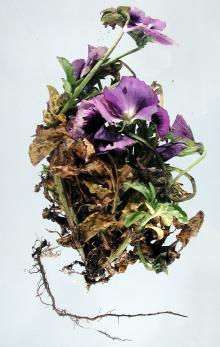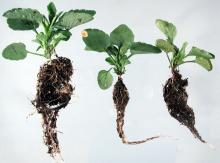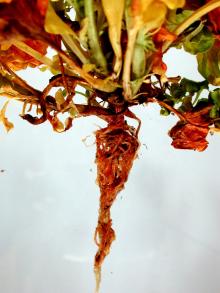See:
Pansy (Viola spp.) - Thielaviopsis Root Rot (Black Root Rot)
Greenhouse Plants, Ornamental - Pythium Seed Rot, Damping-off, and Root Rot
Cause The OSU Plant Clinic has found several Pythium spp. and Phytophthora spp. (such as P. cactorum) associated with root and crown rots of pansy. These fungal-like organisms are favored by cool, saturated soil conditions that encourage spore production, spread and infection. Pythium has also been shown in other hosts to be a problem when soil media, high in soluble salts, repeatedly dries out and is re-wetted. They survive unfavorable periods in soil and infected plant debris. Under favorable conditions, spores germinate and infect roots. After infection, the fungus-like microorganism spreads mainly in the inner bark tissues of the root and stems. A thick-walled survival structure, oospores, are produced that can persist for several years. Movement of infected plants and/or soil can spread the organism.
Symptoms Lack of a functional root and crown system will result in a general yellowing, stunting, wilting, collapse, and death of the plant. Lower leaves may show symptoms first. Roots will be brown, water-soaked and mushy if they are present at all. Decay may continue up into the crown of the plant. Once girdled the plants die. Symptoms can occur any time from seed emergence to mature plants. Wilted plants may be easily pulled off the soil/media surface if crowns have rotted. Can be confused with black root rot or fungus gnat larval feeding.
Cultural control
- Destroy infected plants and debris.
- Inspect all plugs and cuttings for signs of infection.
- Growing media pH should be 5.5 to 5.8 and temperature about 68°F. Check electrolyte concentration levels regularly. Note that pansies tend to naturally increase the growing media pH.
- Do not overwater plants. The soil should dry only slightly between waterings.
- Use new trays and pots with clean soilless media. If pots must be reused then wash off all debris and soak in a sanitizing solution or treat with aerated steam for 30 min.
- Use sterile soil or potting mix to start seeds. Also disinfect any tools and equipment that might be used and contaminate the media.
- Rotate plantings in the garden.
Chemical control Use before symptoms develop. Rotate fungicides with different modes of action to prevent the development of resistant organisms.
- Adorn at 1 to 4 fl oz/100 gal water plus another fungicide. Group 43 fungicide. 12-hr reentry.
- Aliette at 1.25 to 4 lb/100 gal water. Do not use with adjuvants. Group P7 fungicide. 24-hr reentry.
- Areca at 1.25 to 4 lb/100 gal water as a foliar application. Group P7 fungicide. 12-hr reentry.
- Banol at 2 to 3 fl oz/10 gal water. Group 28 fungicide. 12-hr reentry.
- Banrot 40 WP at 4 to 8 oz/100 gal water. Group 1 + 14 fungicide. 12-hr reentry.
- Empress at 1 to 3 fl oz/100 gal water can be used for seedlings. Group 11 fungicide. 12-hr reentry.
- Fosphite at 1 to 2 quarts/100 gal water. Do not use copper products within 20 days of treatment and do not use spray adjuvants. Group P7 fungicide. 4-hr reentry.
- Mefenoxam 2 AQ at 0.12 to 0.24 fl oz/100 gal water as a soil drench at seeding. Group 4 fungicide. No restrictions on reentry when used as a soil drench or media incorporation.
- MetaStar 2E at 0.25 to 0.5 fl oz/100 gal water as a soil drench at seeding, at 0.5 to 2 fl oz/100 gal water at transplanting, and see label for media incorporation. Group 4 fungicide. No restrictions on reentry when used as a soil drench or media incorporation.
- Monterey Garden Phos at 1 teaspoons/8 gal water as a soil drench. Group P7 fungicide. H
- Proplant at 2 to 3 fl oz/10 gal water. Group 28 fungicide. 12-hr reentry.
- Segway SC at 1.5 to 6 fl oz/100 gal water. Drench rate is based on pot diameter. 12-hr reentry.
- Stature SC at 6.12 to 12.25 fl oz/100 gal water. Group 40 fungicide. 12-hr reentry.
- Subdue MAXX at 0.13 to 0.25 fl oz/100 gal water. Apply 1 pint of solution per 1 sq ft. Group 4 fungicide. No restrictions on reentry when used as a soil drench.
- Terrazole 35 WP at 3.5 to 10 oz/100 gal water. Group 14 fungicide. 12-hr reentry.
Biological control Use in conjunction with other control tactics.
- RootShield Plus Granules (Trichoderma harzianum Rifai strain T-22 and T. virens strain G-41) at 1 to 3 lb/ cubic yard soil mix. No restrictions on reentry required when soil incorporated. O
- Bio-Tam 2.0, Tenet WP, or Obtego (Trichoderma asperellum and T. gamsii) at 0.5 to 1.5 lb/cubic yard of substrate. See label for details and other application methods. No restrictions on reentry when soil incorporated. O
References Blindeman, L., Heungens, K., Goossens, F., and Gobin, B. 2008. Efficacy of fungicides against Phytophthora cactorum on Viola. Communications in agricultural and applied biological sciences 74:749-754.
Moorman, G.W., Kang, S., Geiser, D.M., and Kim, S.H. 2002. Identification and characterization of Pythium species associated with greenhouse floral crops in Pennsylvania. Plant Disease 86:1227-1231.




